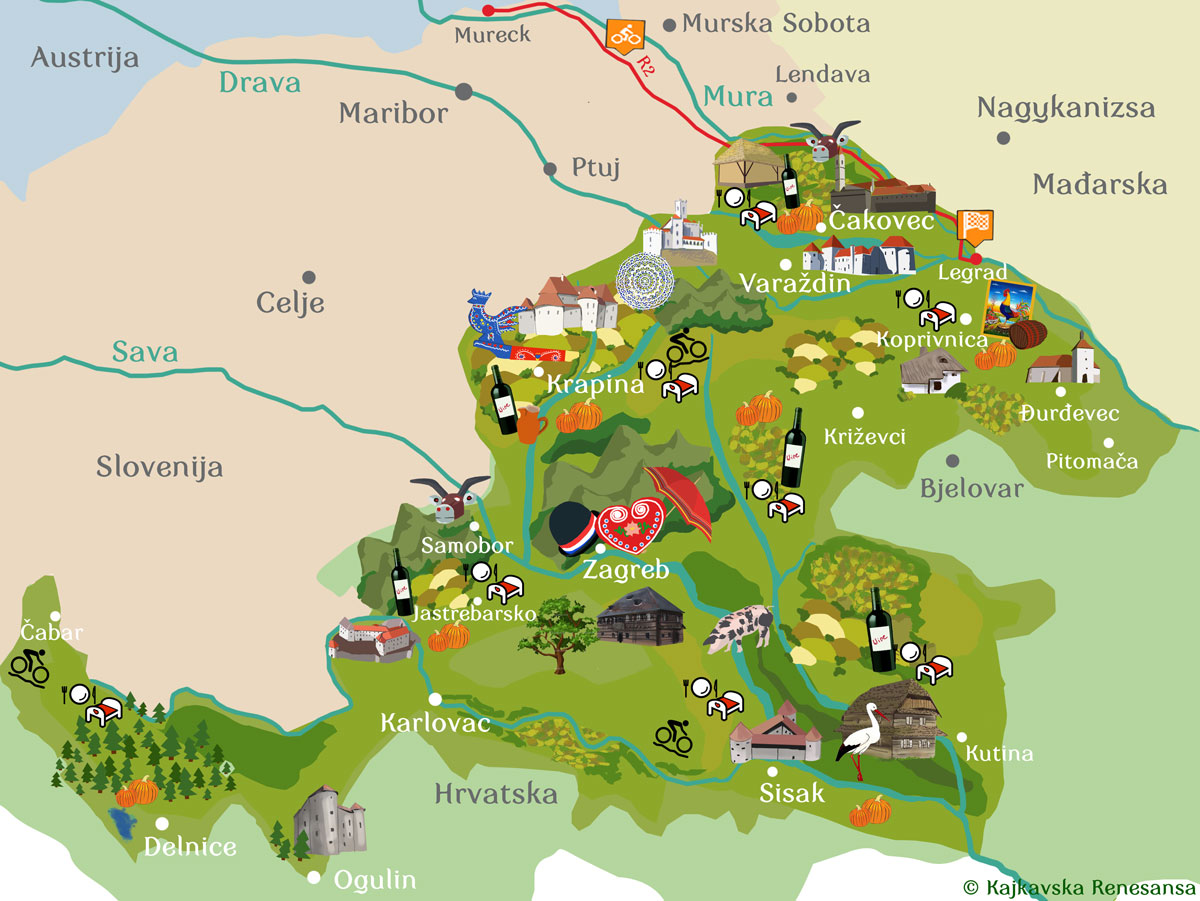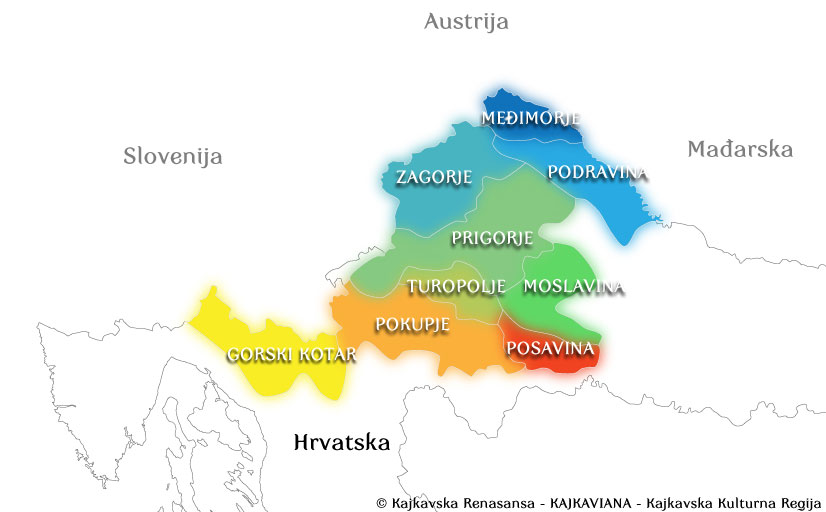


is the cultural and historical region in North Croatia. It is located where mellow Alpine hills meet Pannonian valley. This geographic position within Central-Europe has defined its unique culture, architecture and tradition.
Slovenje means green - green hills, wineyards, valleys and forests, so it is no wonder that oldest traditional Kaikaivan architecture is made of oak wood. There are still traditional wooden churches and even villas.
Slovenje also means flowers that are often presented on Kaikavian folk costumes and sung about in pentatonic folk songs. It means culture, where landscape, spiritual heritage and people become one, as presented in the world famous Kaikavian Art Naive.
Slovenje is a region with more than 1500 years of continuity of culture.
And this is what this site is about - culture. Culture means heritage, arts, creative industries, and even language as vehicle of cultural expressions.
The native language of Slovenje is of course Slovenjski, today know under false name "Kajkavsi" which was imposed by external Croatian and Serbian linguists. Slovenjski language is expressed in one of its 6 main dialects.
Slovenje has 9 main subregions, all of which share common Kaikavian language, culture and tradition. One of the goals of this site is to present this common heritage, making the subregions more coherent through raising awareness of their shared cultural assets, expressions and tradition.
We call the region in north Croatia Slovenje, since it has been its original name for more than 1000 years!
From 18th ct. to mid of 19. ct. the name Horvatska was imposed by Croatian nobility who fled from Croatia because the lost it to Turks. But official language of "Horvatska" remained the same Slovenski language.
Before that Slovenje was known as kingdom (Slovenski orsag or in latin Sclavonia) in Middle Ages.. Did you know that so-called "Kaikavian" writers called their language Slovene? We have numerous written sources that ancestor of today called Kaikavians never called themselves Croats. Their language however was different from todays language of Slovenia and denoted the Kaikavian literary langauge1. As you see, the exterior name shifted, but the content was always preserved - the culture and language. Also, inhabitants of Slovenje were always more similar to Slovenia than to Croatia with who they were geographically divided. Also language of Slovenje is more similar to language of todays Slovenia than the Croatian language. That is why there is also similar and almost same name like Slovenia,
At the very beginning of Europe as we know it, Carolingian sources know Slovenje, its rulers and its inhabitants very well, calling this land Lower Pannonia. Most probably ancestors of today called Kaikavians called themselves at the time of Charlemagne and famous Kaikavian duke Ljudevit of Lower Pannonia Slovenci. What we know for sure it that they did not call themselves "Croats", since already in 11th century writte sources speak of Sclavonia or Slovenski orsag. Croatian name start to appear in Slovenje with Croatian refugees in 15.-16th century. But we know that inhabitants of Slovenje spoke the same language spoken today in this historical region. A langauge which they left us as living heritage. Language that is spoken throughout Slovenje today, being of course similar to Slovene and Slovak (also called Slovenski!). According to linguists language of Slovenje was already distinctly defined around 800 - during the 1st state of prince Ljudevit Posavski!
Slovenjci preserved their unique culture and tradition in customs, mythology like tales and folk songs, and even in sacral architecture, that we present on this site for you to discover. Even today, pre-Christian and pre-Carolingian Slavic elements are alive in Slovenje.
Today folks of Slovenje are understood as distinct cultural and linguistic group living mostly in Slovenje, with a small part in Hungar, and distinct to folks of Slovenia in North.
Economically observed is Slovenje region the most developed region in Croatia (along with Istria), since from its very begining Slovenje has been part of (Central) Europe, sharing and contributing to European cultural, societal and economic development.
Despite of all this, Slovenje, its history and culture are relatively unknown. This site is addressing the challenge of globalisation by presenting uniqueness of Kaikaviana to the public of whole world.
A region whose development is based on culture and sustainable development, and a region that fully interacts with its closer neighbour regions and with broader European context.
This change is happening right now, through the usage of modern information technologies combined with expertise and vision of project-members:
In order to foster Cultural and Linguistic Diversity of Croatia as 4th pillar of sustaianable development, this site presents the unique Slovenje culture - material and immaterial heritage, tradition, arts, and its product that have cultural content or relation - authentic regional food & wine producers, preferably eco; interesting places to stay and to feel the mellow spirit of Slovenje.
Slovenje.eu is made acording to UNESCO “Convention on the Protection and Promotion of the Diversity of Cultural Expressions”, fostering Cultural Diversity in Croatia;
and based on Agenda 21 for culture - understanding of culture as 4th pillar of sustainable development.
Slovenje.eu focuses on rural areas contributing to rural development, clearly showing at the same time that rural can be rich with culture.
is to connect people of Slovenje more with their own culture and heritage, and through this, to connect them with the whole world.
People interested in culture, cultural tourism and sustainable development use this site to explore and discover what is going on in Slovenje. They support local creative & cultural industries and foster sustainable development in rural regions of Kaikaviana - enjoying fresh locally grown eco food & wine, using traditional crafts products based on natural materials, learning about unique material and immaterial heritage of Kaikavians.
1) Kaikavian literary language: http://en.wikipedia.org/wiki/Kajkavian_dialect#Kajkavian_literary_language
slovenje.eu
slovenje.eu was created in 2014 voluntarily as a project of Kaikavian Renaissance to present you the most interesting and unique things from rich Kajkavian culture and region.
A unique blend of artists and architects creted maps and headers.
Mario Jembrih created front end and back end design concept. He created all content and managed it. The portal has more than 150 000 views.
Mario has been paying for development costs as well as for hosting and domain since 2014. He has been managing also another site on Kaikavian language as well as two other Facebook community pages.
If you like this project & idea, you can help us cover the costs for creating & managing this site.
You are welcome to donate:
